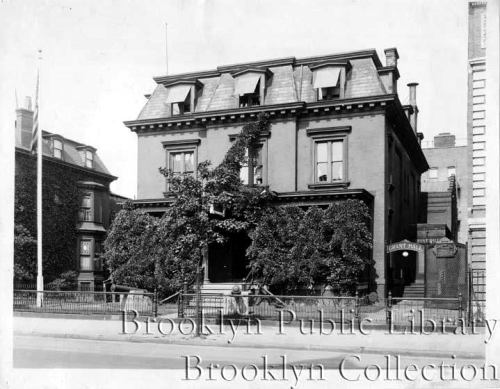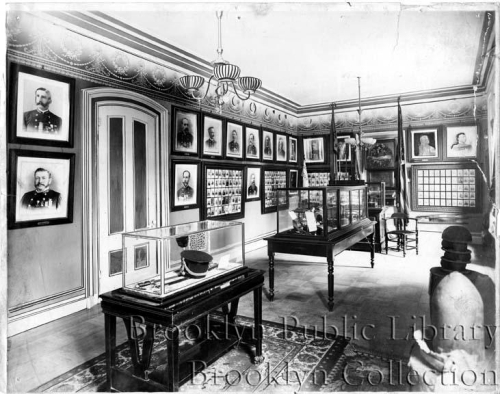Building of the Day: 489 Washington Avenue
Brooklyn, one building at a time. Name: Lascelles E. Maxwell House, then U.S. Grant Hall, then Weber Hall, now Evergreen Church of God in Christ Address: 489 Washington Avenue Cross Streets: Fulton Street and Gates Avenue Neighborhood: Clinton Hill Year Built: Maybe early 1870s Architectural Style: Italianate/Second Empire Architect: Unknown Landmarked: No, just outside the Clinton…

The house in 2012. Photo by Christopher Bride for PropertyShark
Brooklyn, one building at a time.
Name: Lascelles E. Maxwell House, then U.S. Grant Hall, then Weber Hall, now Evergreen Church of God in Christ
Address: 489 Washington Avenue
Cross Streets: Fulton Street and Gates Avenue
Neighborhood: Clinton Hill
Year Built: Maybe early 1870s
Architectural Style: Italianate/Second Empire
Architect: Unknown
Landmarked: No, just outside the Clinton Hill HD
The story: This building is a survivor with a storied past. Looking at its history, it’s amazing how many feet have crossed its floor boards over the years, perhaps more in this building than almost any other private home in Clinton Hill. The old saying, “if walls could talk” certainly applies to 489 Washington Avenue. The house was built at a time when Clinton Hill was still a suburban enclave, consisting mostly of fine villas on large lots on Clinton and Washington avenues. There are very few houses from this period left, as most were razed either for newer mansions in the 1880s, brownstone row house development, or later, for apartment buildings. Here’s the story.
From all accounts, the house was built for Lascelles E. Maxwell and his family. Mr. Maxwell was president of Maxwell & Company, a stock brokerage, and was born in Belfast in 1817. He came to New York in 1825, and became a citizen in 1846. His wife was Grace Georgiana Tone Maxwell, a woman with quite a family tree of her own. Born in Washington, D.C., in 1827, she was the only daughter of Theobald Wolfe Tone, aka “Wolfe Tone,” an Irish revolutionary considered the father of Irish Republicanism. Wolfe Tone was one of the leaders of the United Irishmen, leading the fight to free Ireland from British rule in the late 1700s. He was captured during the Rebellion of 1798, and sentenced to hang. He chose to deny the British the pleasure, and cut his own throat with a pocket knife while in prison. Unfortunately, it took him five agonizing days to die of infection, but he is considered one of the great martyrs in the centuries-old cause of Irish independence.
Lascelles and Grace Maxwell raised seven children in this house. He died at the age of 61, in 1878, here at home, and is buried in Green-Wood. Grace lived here until 1900, when she died at the age of 73. The year before her death, she was listed as one of the wealthiest people in Clinton Hill. After her death, the remaining children in the home held on to it until 1904, when they put the house on the market before all moving to various parts of Westchester.
In 1906, the house became the property of the Ulysses S. Grant chapter of the Grand Army of the Republic. The GAR was a fraternal organization made up of veterans of the Union Army and other Union forces in the Civil War. The organization was founded in Illinois in 1866. They were generally linked with the Republican Party, and early in their existence were powerful proponents for veterans’ benefits, and even black soldiers’ benefits, although that fizzled out after a while. Most Northern cities had GAR posts, and by the turn of the 20th century, the organizations were more of a social club where members wore their old uniforms and reminisced about the war. The Brooklyn chapter was named after Ulysses S. Grant, and had previously met in a rented hall.
After buying the Maxwell house, they took down the walls upstairs, creating a large open meeting room. Downstairs, they turned one of the parlors into a museum, with an impressive collection of military memorabilia, with relics from the Revolutionary War, the War of 1812 and, of course, the Civil War. They had arms, bullets and cannonballs, uniforms, flags, captured Confederate drums, Grant’s desk and chair, even the plume from one of the horses used in Grant’s funeral procession, as well as all kinds of records, newspapers, photographs and other ephemera. The hall became a popular tour destination for local school groups. We have photographs from that period below.
Grant Hall became well known in the community and the hall was rented out to all kinds of groups and for all kinds of events; from meetings to dances, funerals, weddings and private banquets. At least one Civil War era doctor kept his office here. The GAR maintained the hall until 1928, as their numbers began declining, due to death and ill health. The Civil War had been over for 63 years at that point. That year, Grant Hall packed up its collection, donating much of it to the Brooklyn Museum and the Brooklyn Historical Society. The rest of it was sold. In charge of the sale was 86-year-old Richard Harding, who had been one of the young soldiers charged with looking for Edwin Booth after Lincoln’s assassination.
The building was sold to “Professor” A.J. Weber, who operated a dance studio called the Weber Studios. He and his wife taught ballroom dancing, the Fox Trot, Shag, Big Apple, and the waltz. They lived here, and operated the studio from 1928 until 1940. They also continued the tradition of renting out the meeting space to organizations and for events.
At some point thereafter, the house was sold to the Evergreen Church of God In Christ, which has had it ever since. Large mansions tend to either get torn down, or become Pentecostal churches, it seems. Originally, the house was faced in stucco. The white brick face, with the underlying brick showing in spots, has been there since at least the 1980s, as seen in a period tax photo. Private home to veterans’ lodge to dance studio to church. Quite a history. Let’s hope it survives. GMAP












What's Your Take? Leave a Comment